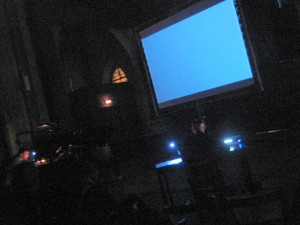Diemo Schwarz
Fine Sound Art since 1993Laïka est morte pour l’Europe at the Saint-Merri church, Paris, with Frédéric Blondy
 Ciné-concert expérimental Laïka est morte pour l’Europe
Ciné-concert expérimental Laïka est morte pour l’Europe
Marion Delage de Luget et Benoît Géhanne, vidéos
Frédéric Blondy, piano et Diemo Schwarz, électronique
&
Daunik Lazro, saxophone solo
http://rendezvouscontemporains.com/rdv/actualite.html
Using the films created by Marion Delage de Luget and Benoît Géhanne like a musical score, Diemo Schwarz and Frédéric Blondy composed pieces that follow a trajectory, a predetermined evolution, within which the playing thrives freely, based on listening to the produced sound and to the resonance with the performance space.
Photo by Marie-Ève Bouillon
For each composition, the aim is to explore in depth a given material, a principle of play, a type of interaction, and to extract from it its essence, its expressive force.
The piano, driving force of the performance setup, is seen here in a very extended way, where the entire body of the instrument, as well as the materials it is made of, are engaged in sound production.
Be it by using preparations, playing inside of the instrument, or extended playing techniques, the acoustic material is extremely rich and diverse, and serves as source for the electro-acoustic setup.
The piano’s acoustic body is electonically doubled with the help of corpus-based synthesis, producing once a sonic shadow, once a parallel space that crosses and interlaces with the sounds of the piano.
Corpus-based concatenative synthesis allows here to recontextualise the sounds captured and analysed in real-time, and to precisely navigate in the timbral space spanned up by the sounds of the piano, nourishing the corpus all along the performance.
Utilisant les films réalisés par Marion Delage de Luget et Benoît Géhanne comme des partitions, Diemo Schwarz et Frédéric Blondy ont composé des pièces qui suivent un cheminement, une évolution prédéterminée, à l’intérieur desquelles le jeu reste libre, basé sur l’écoute de ce qui est produit et de la résonance avec le lieu de la présentation.
Le piano, source motrice du dispositif, est envisagé de manière très étendu où le corps entier de l’instrument ainsi que les différents matériaux qui le constituent sont engagés dans la production sonore. Que ce soit par l’utilisation de préparations, d’un jeu à l’intérieur de l’instrument ou de techniques instrumentales étendues le matériau acoustique extrêmement riche et diversifié sert de source au dispositif électro-acoustique.
Ce corps sonore acoustique est doublé électroniquement par le dispositif de synthèse par corpus, produisant tantôt une ombre sonore, tantôt un espace parallel qui se croise et s’entrelace sans cesse avec les sons du piano. La synthèse concaténative par corpus permet ici de récontextualiser les sons captés et analysés en temps-réel et de naviguer avec précision dans l’espace timbral étendu par les sons du piano, qui nourrit le corpus tout au long de la performance.
Comments are closed
You must be logged in to post a comment.